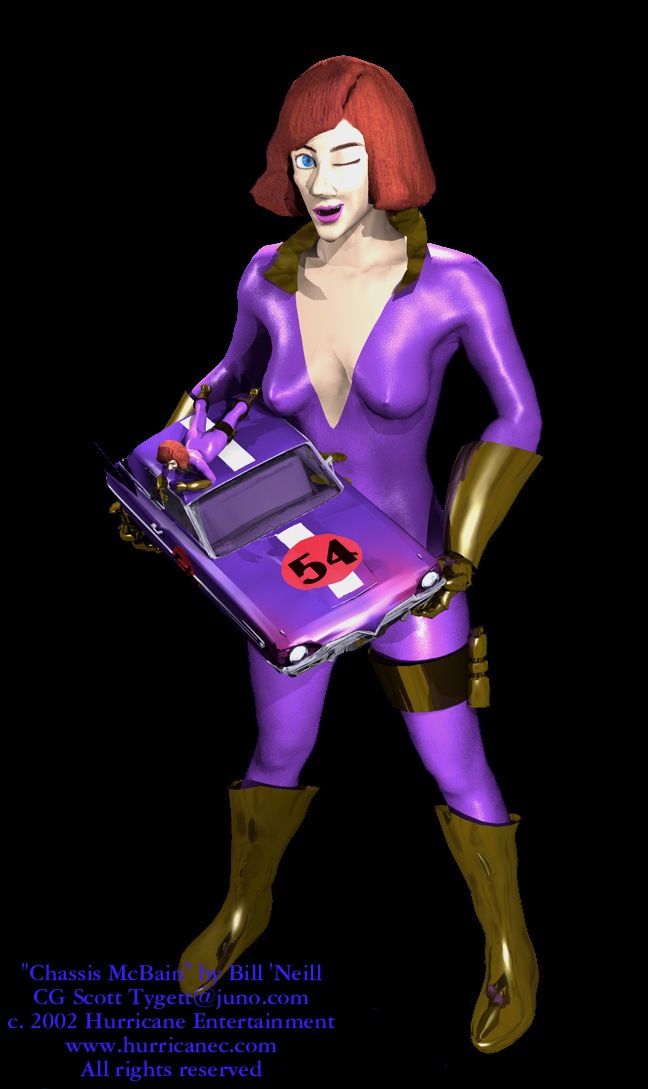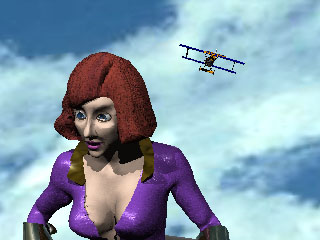|
|
|
GALLERY CONTINUED
PAGE FORTY-FIVE

Bill O'Neill's character "Chassis McBain," more or less. To see some other artists' interpretations of his character, visit the www.hurricanec.com website.
The CAD object was re-stenciled for a different costume, but the same head was used as before, though it went through several incarnations. Most of the costume accessories are from earlier versions of the character. The lighting was trial-and-errored: a spot light on the toy car, a point light on the face, a fairly hot backlight, another spotlight on the legs, and a point light for the body. The wink is just "Pole2" in the area of the eye. This character is fully bones rigged, so different head and camera positions were tried. In this version, paint boxing was used for the details like eyelashes and a neck that's still under revision.
It was suggested I try a larger chest, so I took the opportunity to add a bodice effect as well.

The open neck near the navel was achieved by copying the chest area to another object, and then resurfacing the skin area with a different name and making it transparent. Since INSPIRE's modeller cannot show transparency, the polygons were made single-sided and were "flipped" to get the same effect in Modeller. Then the surface area was magnet-adjusted and smoothed in another layer to give the result above. The same trick used with the photoreal characters was used, of having two layers open, and the "selected" area magnetted to show through, in this case, making the leotard slightly larger than the chest. The outer points were "BGConform"ed, and the result pasted and "merged," to give this result.
This kind of character animation is going to be tricky with INSPIRE: the whole figure was one object, including the head, so eye movement, face-shapes and hand gestures were all going to have to use that one figure's 40 possible morph poses. Although the eyebrows in this image are textured, that probably isn't practical without UV mapping, because a LOT of face shape characterization flows from the brows. To make this sort of project work for INSPIRE and the average PIII, one is going to have to create a fair number of proxies AFTER one creates the morphs. This is an awful lot of trouble even to create a "trailer" to pitch a project to investors.
On the other hand, proxy morphing is a good idea, either by cutting off the body from a figure at a determined row of polygons, or using a stand-in made of cubes. A cube with a mouth can still be "BGConformed" to one's actual model, with a little tweaking before hitting the "BGConform" button, it may even produce worthwhile lip-synch. Trading hair and other accessories for low poly versions and deleting everything but the head is probably also worthwhile. And why? Because "improvisation" is the way to get performance, not waiting long intervals for the display to refresh.
The script for this little piece evolved along with dozens of tests. Tests of twitching dancing models, walk cycles tests, then a run cycle test, then adding a zeppelin for running along, then adding a flying car about to slide off the "Lanaberg" to give a motivation, then a plane to be the cause for the parked car to begin to slide. The result was about thirty seconds after a lot of redo's, such as adding twist and fixing some pretty lame mistakes like not making sure the cycles had identical slope transitions at the start and end.
< BACK . . . . . . . . . . . . . . < HOME > . . . . . . . . . . . . . . NEXT >